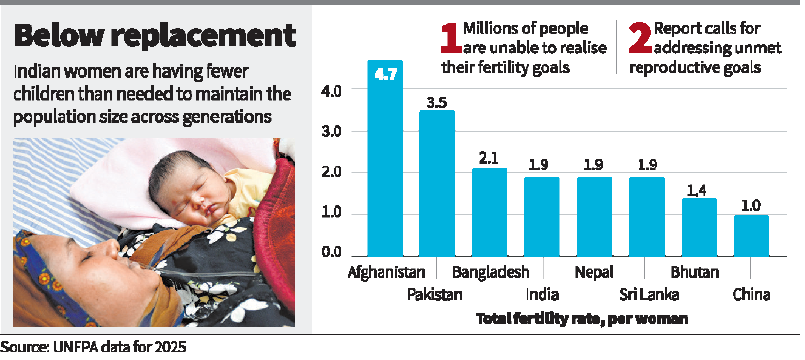India’s Population Hits 146.39 Crore – UNFPA’s State of World Population 2025 Report

1. Population Estimates & Global Rank
-
As of April 2025, India’s estimated population is 146.39 crore, according to the United Nations Population Fund (UNFPA) report titled “State of the World Population 2025: The Real Fertility Crisis”.
-
This figure confirms India’s status as the most populous nation, ahead of China’s 141.61 crore.
2. Fertility Trends
-
Total Fertility Rate (TFR) has declined to 1.9, below the replacement level of 2.1.
-
Replacement level TFR refers to the number of children each woman must have to replace the existing population.
-
-
According to the Sample Registration System (SRS) Statistical Report 2021 by the Office of the Registrar General of India:
-
TFR was 2.0, same as in 2020.
-
The report confirms that India has attained replacement level fertility at the national level.
-
-
TFR is a key demographic indicator measuring the average number of children a woman is expected to have during her reproductive years.
3. Population Projections
-
India’s population is projected to peak at 170 crore in about 40 years, followed by a gradual decline.
4. Age Structure
-
Working-age population (15–64 years): 68%
-
Children (0–14 years): 24%
-
Adolescents (10–19 years): 17%
-
Youth (10–24 years): 26%
-
Elderly (65+ years): 7% — this segment is expected to increase with improvements in life expectancy.
5. Life Expectancy (2025 projections)
-
Men: 71 years
-
Women: 74 years
6. India’s Own Projections
-
India’s 2019 population projection by a technical expert group estimated a population of 141.10 crore for the year 2025 — close to the UNFPA's figure.
7. Census Delay
-
India’s decennial Census, originally scheduled for 2021, has been delayed.
-
Government has now announced completion by March 2027.
-
The last Census was conducted in 2011.
-
8. UNFPA’s Focus – “The Real Fertility Crisis”
-
The report argues the real issue is not overpopulation or underpopulation, but the inability of people to achieve their reproductive goals.
-
It advocates for reproductive agency — defined as a person’s right and ability to make free and informed decisions about sex, contraception, and family planning.
9. Data Sources and Methodology
-
The report draws from:
-
Nationally representative household surveys such as:
-
Demographic and Health Surveys (DHS)
-
Multiple Indicator Cluster Surveys (MICS)
-
-
Estimates from UN organizations and inter-agency bodies
-
Latest updates from:
-
World Population Prospects: 2024 revision
-
Model-based Estimates and Projections of Family Planning Indicators 2024 (UN DESA Population Division)
-
-
